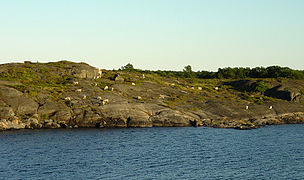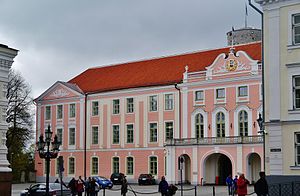Menako Islands
Menako Islands | |
|---|---|
Motto: "Klen ensam - Grotna samna" | |
| Capital | Norstätt |
| Official languages | |
| Recognised national languages | Hellonian, German |
| Ethnic groups (1950) | 64.3% indigenous population 18.7% Hellonian 18.5% German 7.5% Others |
| Demonym(s) | Menakan |
| Government | Unitary parliamentary constitutional monarchy |
• King | Kristoffer of Hellona |
• Minister-Governor | Sanne Bränne |
| Legislature | Lageding |
| Establishment | |
• Formation of the Menako kingdoms | 500 |
• Joined Hellona or USGS | 1786 |
• Unification | 1886-now |
| Population | |
• 1888 estimate | 1.055.900 |
| Currency | Hellonian krona (HEK) |
| Date format | dd/mm/yyyy (CE) |
| Driving side | right |
| Internet TLD | .mi, .hl [a] |
| |
The Menako Islands (Menakan: ᛗᛖᚾᛋᛕᚨᚱᛟJᚨᚱᚾ Menskarojarn, Hellonian: ᛗᛖᚾᛋᛕᛟᛖᚱᛖᚾ Menskoepen, German: Menskupen) is constituent country of the Hellonian Realm. It is located in the middle of the Danonian Sea.
The Menako Islands can trace their history back to the first Vismaric settlers starting from 500. These early Vismaric settlers would establish their own culture and states on the islands, with others sailing further and eventually establishing communities in contemporary Norsund. Starting from the 7th century, Hellonian and German expeditions led to the discovery of the islands by Hellonians and South Germans. It would lead to the establishment of a long-time dependency of the islands on these two nations, which partioned them in two zones of influence. Under their control, the islands would come to be important trading hubs in the Hellonian and German colonial empires. Greater autonomy to the Hellonian side of the islands was granted in 1865. With the ratification of the Acts of Union in 1886, the unification of the United South German States and Hellona led to the unification of the Menako Islands as a constituent country in the Hellonian Realm. When the Vismar Union dissolved itself in 1912, the Menako Islands as one entity became a constituent country in the Hellonian Realm.
Etymology
The name of the Menako Islands finds its origin in the local name for the islands: Menskarojarn. It itself comes from the Menakan words Menskar meaning "People" and ojarn meaning "the islands". The name refers to what the indigenous people thought and lived, they saw themselves as the only humans on this earth and called their land "the people's land". Most Vismaric languages use the native name as a base, Hellonian (oe reflects the pronunciation in Menakan) and German included.
History
Prehistory and kingdoms
Evidence of life on the Menako islands has been seen since around 100 A.D. Tribes living on these islands we're hunter-gatherers, but quickly joined together to make small kingdoms. Many sculptures have been found which proof that these kingdoms started around 500.
Menakans are decendants of the first Vismarics sailing across the Danonian Sea, some of which ended up in Norsund, including the ethno-linguistic similar Vejorda people.
Menakan wars (620-750)
At around 600, there were three known kingdoms on the 6 isles: Afrik, Essel and Jerlän. Scriptures have been found at around 589, in a script now called the Futark. These tell of the great Menakan wars that happened from 620 to 750. The wars were between the three kingdoms, which fought for dominance in the region. Jerlän was ill-prepared and lost major battles at Grotnakap and the gulf of Alsten, which all resulted in the conquest of the Jerlän by the Afrik around 680. However both Essel and Afrik had a hard time against each other, and fighting continued untill around 750, when both kingdoms declared peace. The islands were split up equally by the two kingdoms and peace returned.
Germano-Hellonian trade
As early as 679, traces of Hellonian and German presence have been found on the isles. Most were there for trade, and the Hellonian government asked Afrik for a trade monopoly with them, and they accepted. Hellonian immigrant came to the isles and began to set up trade posts. The Germans began to do the same in the Jerlän kingdom. The Menakan people enjoyed these new groups of people, and on 1786 a treaty was sent their way. The kingdoms of Afrik and Jerlän were asked by both the USGS and Hellona to join their countries as special constituent countries, and they accepted. They became special dominions on Feburary 6th, 1786.
unification (1886-now)
When Hellona and the USGS combined to make Germano-Hellona, the Menakan people asked for a unification as one constituent country. This was fulfilled and the Menako islands became one state on April 6th, 18886.
Geography
The Menako Islands occupy a position of strategic importance, as they lay in the middle of the Danonian sea. Hellona uses the islands as a stop for traveling to Norsund and is used as a trade point between the two countries.
The Menako archipelago consists of six habitable islands, of which two are inhabited. the remainder are merely some 200 desolate rocks. The archipelago is the only island chain in the Danonian sea and makes a strategic point for both travel to Novallonda and the Arctos ocean.
The surface of the islands is generally rocky and the soil thin. There are several harbours.
Bio diversity
Animals include about a 1000 types of insects, and several kinds of mammals. There is no known population of reptiles. Mammals include the Menakan sheep and the Menakan horse. The islands is also home to many sea-birds.
The mildness of the climate and the richness of the soil made the island chain hospitable for many species of vegetation. Pines and firs, birch, aspen, elm, ash, and lime grow, and oaks occur in small woods all over the chain. Traditionally, timber was exported for shipbuilding and houses, while clay was only used for castles for the kings.
Politics
Constitutional framework
As a constituent country of the Hellonian Realm, the highest legislative and executive powers of the Menako Islands lie in the Aldag and its council of ministers. In reality, the constituent countries only cede control over military and the monetary policy to this Realm-wide parliament. In 1886 the now-unified Menako Islands were granted home rule. Contemporary Menakan politics is based on two of its founding documents, the Constitution of the Unified Menako Islands and the Charter for the Realm. They can only be changed by a two times two-thirds majority in the Lageding, separated by a general election, or in case of the Charter for the Realm, an absolute majority in the Aldag.
The Menako Islands have a parliamentary democracy under a constitutional monarchy, with King-Exalt Kristoffer acting as the current head of state. The role of the monarch within the actual politics of Norsund is extremely limited to ceremonial and representative functions. By extension, the King-Exalt of Hellona also acts as the monarch of the entire Hellonian Realm. The monarch does not send a representative in his place, with the executive power of the monarch being invested in the Minister-Governor. The monarch and the Royal Family undertake a variety of other unofficial representative duties in Hellona, the Realm and abroad. The monarch also acts as head of the Asatru faith, hence the title of King-Exalt. Officially both titles are seen as separate and only held by the same person.
Government
The Government of the Menako Islands holds executive powers over the country. The Government consists of the Minister-Governor, selected by a vote in the Lageding, and other ministers selected by the Minister-Governor.
The legislative power in the Menako Islands are vested in the Lageding, the unicameral parliament of the islands and its 67 members. General elections are held every four years. Legislation may be initiated by either the Government or members of the Lageding. Members are elected on the basis of party-list proportional representation with a chance for a preferential vote for a certain member to a four-year term. The system for the Lageding is directly based on that of the Ryksdag of Hellona.
The Menako Islands have a multi-party democracy, with many active political parties. This means that in practise, no one party manages to win a majority. This necessitates the need for coalitions between parties. Currently three parties form the Government of the Menako Islands, with 7 parties in total seated in the Lageding. Currently, the parties in the Lageding are: Republic, the Native Coalition, the Centre, the Nationals, Union, New Ways and one independent, Rasmus Winsson.
Administrative divisions
The Menako Islands are divided in provinces, one for each island. The biggest islands and thus provinces being Volland and Mennern. The islands are further divided into muncipalities (Menakan: Gemenar, Hellonian: Gemeentes, South German: Gemeinden)
|
Demographics
Ethnicity and language
Most people speak Menakan as their first language: 85,5%, while 12,5% speak Hellonian and 12,5% speak German. The language of instruction in publicly financed schools is Menakan, but some schools feature bilingual instructions, in either German or Hellonian.
Even though the country is now unified, most people still identify under the old kingdoms. About 40% identify as Bokumenan, 45% as Seevadian, and 15% are foreigners. Culturally, the Seevadians and Bokumena only have small differences, in language and etiquette, but they mostly have the same culture.
Religion
The majority of the Menakans find that religion is a very personal matter which is not supposed to be propagated in public. People usually only practice religion at home and try to keep it out of their outside life.
Culture
The Menakan culture is similar to the Norsundish Vejorda people and other Vismaro-Novallondan cultures, and has its roots in the Grønheim culture. The Menakan language was long written in its own alphabet, and only has recently changed to the Hellonian system. This is why lately there has been a resurgent of traditional culture, as old stories are being translated.
Literature
Menakan literature has only recently really developed, as the nation changed from the Boselu alphabet to the Hellonian system, many old stories are put in the spotlight again. Old saga's include the Sagan Bronhils and Strojden om Aflännen. These were the bedrocks for modern Menkupan literature, and these classic mythological creatures and gods are still included in daily life and many books.









